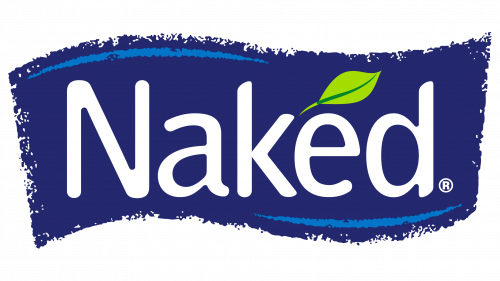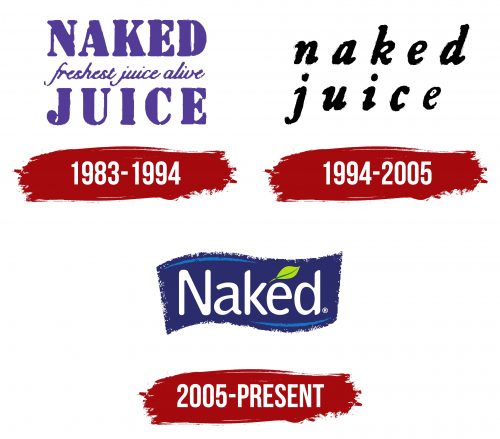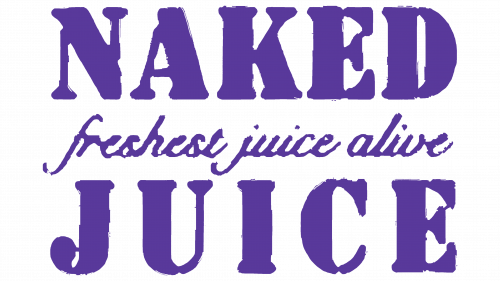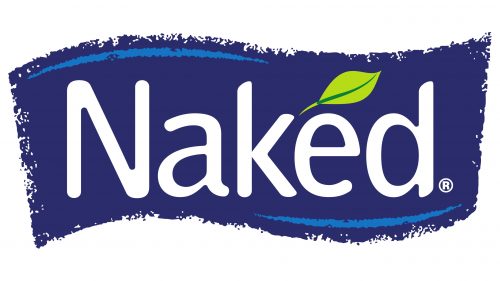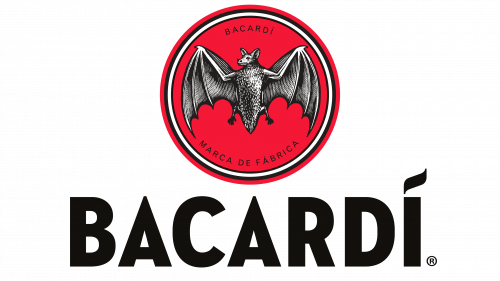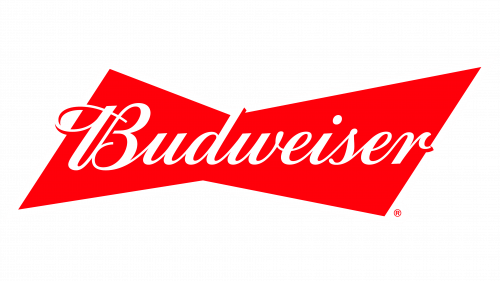The Naked Juice logo is bright, beautiful, easily readable, and clear. However, this is only one of its merits. The developers put a lot of effort into creating a modern identity that engages in an open dialogue with the customer.
Each element of the logo embodies originality and conveys unique content. For instance, the colorful and contrasting green leaf, although small in size, symbolizes the naturalness and environmental friendliness of the product.
Naked Juice knows the quality ingredients for juices and drinks and uses its identity to remind customers of this. Modern graphic sketches make the leaf realistic, enhancing its presentability.
The white capital letters, applied sequentially and in a single line, emphasize simplicity and grandeur. They stand out against the blue background and are smooth without complex textures.
Naked Juice: Brand overview
Naked Juice was founded in 1983 in Santa Monica, California. Jimmy Rosenberg started the business by hawking freshly squeezed juices from a van on Santa Monica beaches. Rosenberg was motivated to make healthy, natural drinks without added sugar or preservatives.
At first, Rosenberg prepared a small number of juices and marketed them to residents and visitors under the name Naked Juice. The moniker “Naked” highlighted the juice’s naturalness and purity without additives.
The brand’s popularity increased during the 1980s, and the business grew. Before the decade’s end, products were available at Southern California farmers’ markets and small health food stores.
The company saw substantial development during the 1990s. The business started experimenting with different blends and flavors, creating creative ways to combine fruits and vegetables. Popular goods like Green Machine, a smoothie made with green fruits and vegetables, were introduced during this period.
A significant milestone in the firm’s growth was reached in 2000 when a new production facility in Azusa, California, was opened. As a result, the business was able to boost production levels and broaden its nationwide distribution network greatly.
A major turning point in the company’s history occurred in 2006. PepsiCo paid an unknown sum to acquire the business. This transaction made new development and expansion options possible by giving the company access to PepsiCo’s vast distribution network and marketing resources.
After acquiring PepsiCo, the firm kept developing new ideas and expanding its product line. The high-protein Protein Zone smoothie line was introduced in 2007, emphasizing consumers who lead busy lifestyles and are fitness lovers.
In 2009, the brand launched the Naked Coconut Water product line in response to the increasing popularity of coconut water as a natural sports drink.
The 2010s were a time of continued innovation for the company. The corporation kept adding new flavors and styles to broaden its selection. The Reduced Calorie Smoothies range was introduced in 2012 and aimed at consumers who wanted to limit their calorie intake.
The firm encountered legal problems in 2013 because of its marketing claims regarding the naturalness of its goods. To resolve a class-action lawsuit, the corporation paid $9 million and stopped using ” all-natural ” in its packaging.
The Naked Pressed brand of cold-pressed juices was introduced in 2015 to position it as a high-end product with optimal nutrient retention.
The company’s post-2015 history continues: in 2016, it introduced Bright Beets, a new addition to its lineup. The increasing interest of consumers in beet juice and its possible health advantages led to the development of this product. Bright Beets created a distinctive flavor profile by combining beet juice with various fruits and vegetables.
Naked Probiotic, a range of probiotic-enriched smoothies, was introduced in 2017. This invention was a response to the expanding market for gut-healthy products. Multiple flavors of Probiotics were available, and each one included billions of living probiotic bacteria.
2018 saw the corporation prioritize environmental responsibility and sustainability. The firm declared that it would be switching to recycled plastic bottles. This program was a component of PepsiCo’s larger plan to reduce plastic waste.
2019 saw significant advancements in the field of low-calorie products. The Light range of smoothies was launched, providing high-nutrient, low-calorie, and sugar-free options.
The company increased its market share by introducing the Plus line of functional beverages in 2020. As the market for drinks with extra health advantages grew, these products were enhanced with extra nutrients like collagen, vitamin D, and antioxidants.
For the firm, 2021 was a year of emphasis on digital marketing. The corporation started a massive web campaign to increase public knowledge of its products’ nutritional worth. The campaign featured instructional content about the advantages of fruits and vegetables and partnerships with lifestyle influencers.
In 2022, the brand launched a new range of fruit juice-infused cold teas. The goal of creating this line was to attract more customers and increase the brand’s visibility for refreshing beverages.
For the company, 2023 was a year of plant-based protein studies. The business introduced a line of plant-based protein smoothies made with peas, pumpkin seeds, and other forms of plant protein. This invention addressed the rising demand from consumers for vegan-friendly products and plant-based substitutes.
With its primary goal of offering natural, nourishing drinks, the company keeps up with evolving trends in the healthy eating sector.
Meaning and History
What is Naked Juice?
It is a brand that specializes in producing a variety of fruit and vegetable juices and smoothies. The company was founded in Santa Monica, California and is currently owned by PepsiCo. It is known for its desire to create beverages from natural ingredients without added sugar, preservatives, or artificial flavors. The brand offers a wide range of products including cold-pressed juices, protein smoothies, and probiotic drinks. The company emphasizes health and well-being, aiming to offer nutrient-rich products that support a balanced lifestyle. The products are widely available in supermarkets, health food stores and online retailers.
1983 – 1994
In 1983, a company emerged that offered real, freshly squeezed juice capable of revolutionizing the food industry. The brand’s innovative approach is reflected in its logo.
The name “Naked Juice” is printed in capital letters to emphasize its grandeur and uniqueness. The two words are placed on different horizontal planes, showcasing an unconventional approach to product production. The purple letters on a white background clarify, highlighting that the brand inspires love at first sip.
The logo also features the phrase “the freshest juice of all,” which demonstrates the brand’s commitment to the health and well-being of its customers. These three words, written in cursive on a single line, serve as the primary informational block of the identity, indicating the quality and freshness of the product.
1994 – 2005
A creative approach to creating an identity doesn’t always involve using bright colors and accents. Classic motifs are often used as a foundation. This concept can be seen in the identity of the brand “Naked Juice,” known for its delicious and healthy juices.
In 1994, a simple but striking logo made a strong visual impression. It was presented without special effects or exaggerations, emphasizing its restraint and elegance.
The logo consists of two words and ten letters, without drawings or patterns. The text, written in cursive with uniform letters, gracefully forms the name “Naked Juice” on a white background. Capital letters are not used.
The logo’s design reflects the product’s simplicity, clarity, naturalness, and accessibility. Its lightness and noticeable dynamism attract attention, inviting people to try the delicious juice.
2005 – today
In 2005, elegance and restraint regained vibrancy, aligning with modern trends. Due to technical innovations and new resources, simplicity ceased to impress consumers. Black-and-white letters took on new shapes, and vibrant colored elements added expressiveness.
The color scheme underwent a radical change, new fonts were introduced, and graphic elements were distributed according to the company’s overall philosophy and image. Dynamism prevailed, leaving static design behind. The new logo conveyed a wealth of information, focusing on the essentials.
An interesting innovation was the background, which had not been used before. It features a geometric shape resembling a wave or a broad brushstroke with blurred edges, creating a sense of freedom and infinity. The blue background symbolizes a water connection.
Against the blue background, white letters are placed sequentially to look graceful and beautiful, like young ladies. The symbolism of purity and freshness is predominant. To enhance readability, strokes were added to the letters’ upper left and lower right corners, creating emphasis. A green leaf symbolizes new life and natural beauty.
